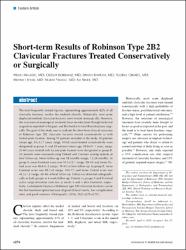| dc.contributor.author | Malkoç, Melih | |
| dc.contributor.author | Korkmaz, Özgür | |
| dc.contributor.author | Bayram, Erhan | |
| dc.contributor.author | Örmeci, Tuğrul | |
| dc.contributor.author | İşyar, Mehmet | |
| dc.contributor.author | Yılmaz, Murat | |
| dc.contributor.author | Şeker, Ali | |
| dc.date.accessioned | 10.07.201910:49:13 | |
| dc.date.accessioned | 2019-07-10T20:02:16Z | |
| dc.date.available | 10.07.201910:49:13 | |
| dc.date.available | 2019-07-10T20:02:16Z | |
| dc.date.issued | 2016 | en_US |
| dc.identifier.citation | Malkoç, M., Korkmaz, Ö., Bayram, E., Örmeci, T., İşyar, M., Yılmaz, M. ve Şeker, A. (2016). Short-term results of robinson type 2B2 clavicular fractures treated conservatively or surgically. Orthopedics, 39(2), E276-E279. https://dx.doi.org/10.3928/01477447-20160201-04 | en_US |
| dc.identifier.issn | 0147-7447 | |
| dc.identifier.issn | 1938-2367 | |
| dc.identifier.uri | https://dx.doi.org/10.3928/01477447-20160201-04 | |
| dc.identifier.uri | https://hdl.handle.net/20.500.12511/3601 | |
| dc.description | WOS: 000377511000013 | en_US |
| dc.description | PubMed ID: 26881465 | en_US |
| dc.description.abstract | The most frequently treated injuries, representing approximately 82% of all clavicular fractures, involve the midshaft clavicle. Historically, most acute displaced midshaft clavicular fractures were treated nonsurgically. However, the outcomes of nonsurgical treatment have recently been thought to be not as good as expected in the past, and the trend is to treat these fractures surgically. The goal of this study was to evaluate the short-term clinical outcomes of Robinson type 2B2 clavicular fractures treated conservatively vs with locked plate fixation. Among 59 patients included in the study, 30 patients (mean age, 45 +/- 13.7 years; range, 30-62 years) treated conservatively were designated as group A, and 29 patients (mean age, 38.8 +/- 11.1 years; range, 20-60 years) treated with locked plate fixation were designated as group B. All patients were evaluated using Oxford and Constant scoring systems at final follow-up. Mean follow-up was 18 months (range, 12-24 months). In group A, mean Constant score was 70.5 +/- 15.1 (range, 98-43) and mean Oxford score was 46.6 +/- 1.3 (range, 49-44) at final follow-up. In group B, mean Constant score was 89.2 +/- 8 (range, 100-77) and mean Oxford score was 46.5 +/- 1.2 (range, 48-44) at final follow-up. Callus was detected radiographically in both groups at 6-week follow-up. Patients in groups A and B started active range-of-motion exercises at weeks 6 and 3 after treatment, respectively. Locked plate fixation of Robinson type 2B2 clavicular fractures can be the first treatment option because of good clinical results, low complication rates, and good cosmesis. | en_US |
| dc.language.iso | eng | en_US |
| dc.publisher | Slack Inc | en_US |
| dc.rights | info:eu-repo/semantics/openAccess | en_US |
| dc.subject | 2B2 | en_US |
| dc.subject | Clavicular Fractures Treated | en_US |
| dc.subject | Conservatively or Surgically | en_US |
| dc.title | Short-term results of robinson type 2B2 clavicular fractures treated conservatively or surgically | en_US |
| dc.type | article | en_US |
| dc.relation.ispartof | Orthopedics | en_US |
| dc.department | İstanbul Medipol Üniversitesi, Tıp Fakültesi, Cerrahi Tıp Bilimleri Bölümü, Ortopedi ve Travmatoloji Ana Bilim Dalı | en_US |
| dc.department | İstanbul Medipol Üniversitesi, Tıp Fakültesi, Dahili Tıp Bilimleri Bölümü, Radyoloji Ana Bilim Dalı | en_US |
| dc.authorid | 0000-0003-1259-6668 | en_US |
| dc.authorid | 0000-0002-4843-5121 | en_US |
| dc.authorid | 0000-0001-7068-2033 | en_US |
| dc.authorid | 0000-0001-8532-4917 | en_US |
| dc.authorid | 0000-0001-9052-4411 | en_US |
| dc.authorid | 0000-0003-1259-6668 | en_US |
| dc.identifier.volume | 39 | en_US |
| dc.identifier.issue | 2 | en_US |
| dc.identifier.startpage | E276 | en_US |
| dc.identifier.endpage | E279 | en_US |
| dc.relation.publicationcategory | Makale - Uluslararası Hakemli Dergi - Kurum Öğretim Elemanı | en_US |
| dc.identifier.doi | 10.3928/01477447-20160201-04 | en_US |
| dc.identifier.wosquality | Q4 | en_US |
| dc.identifier.scopusquality | Q2 | en_US |


















